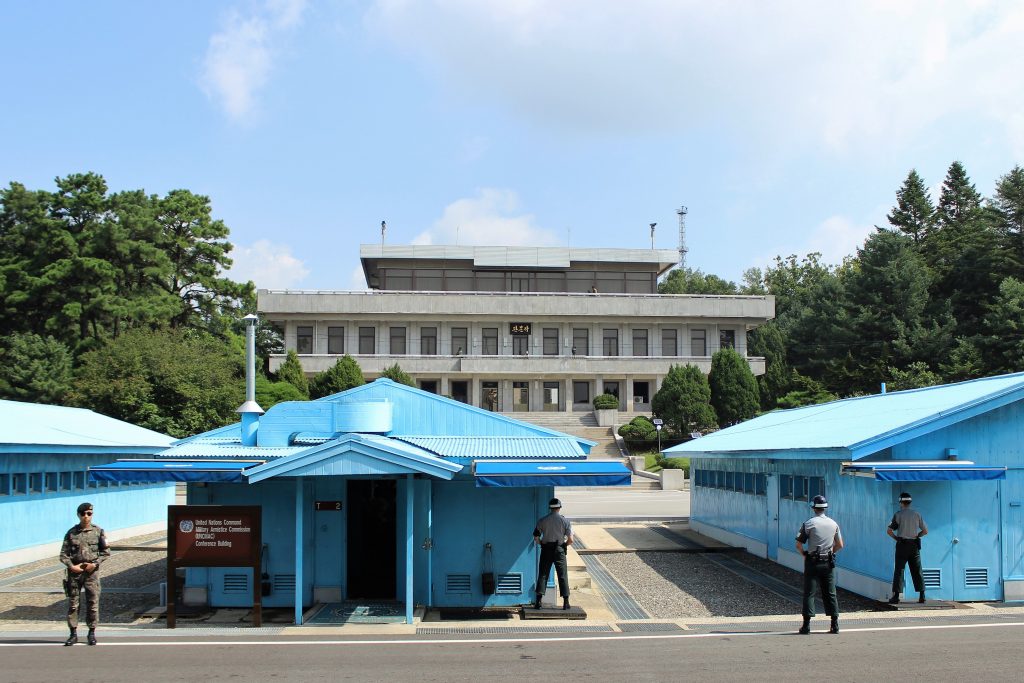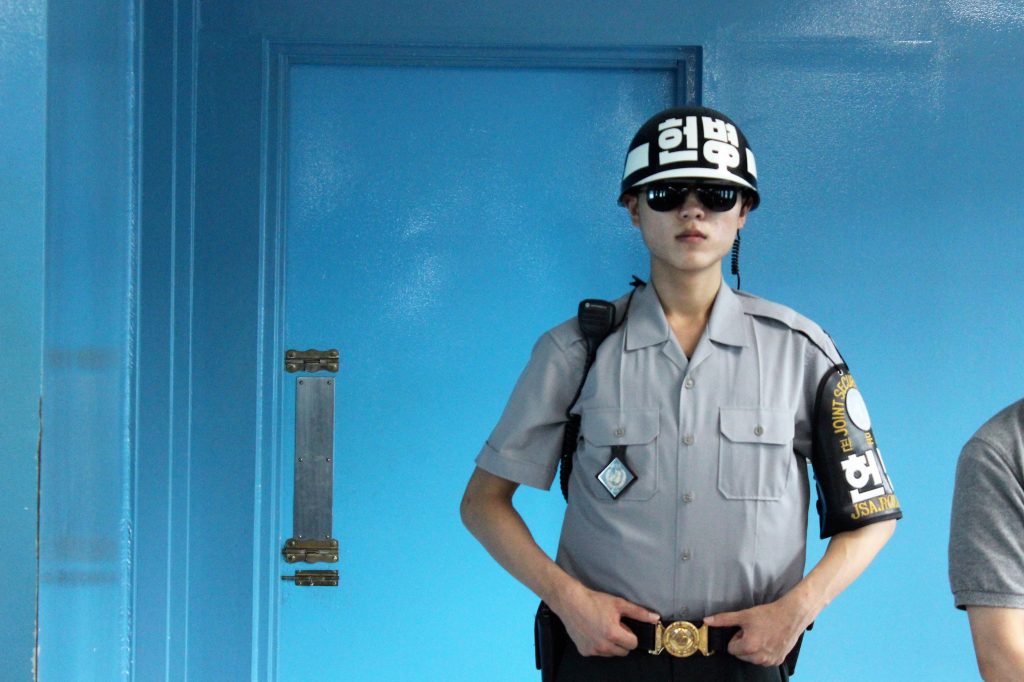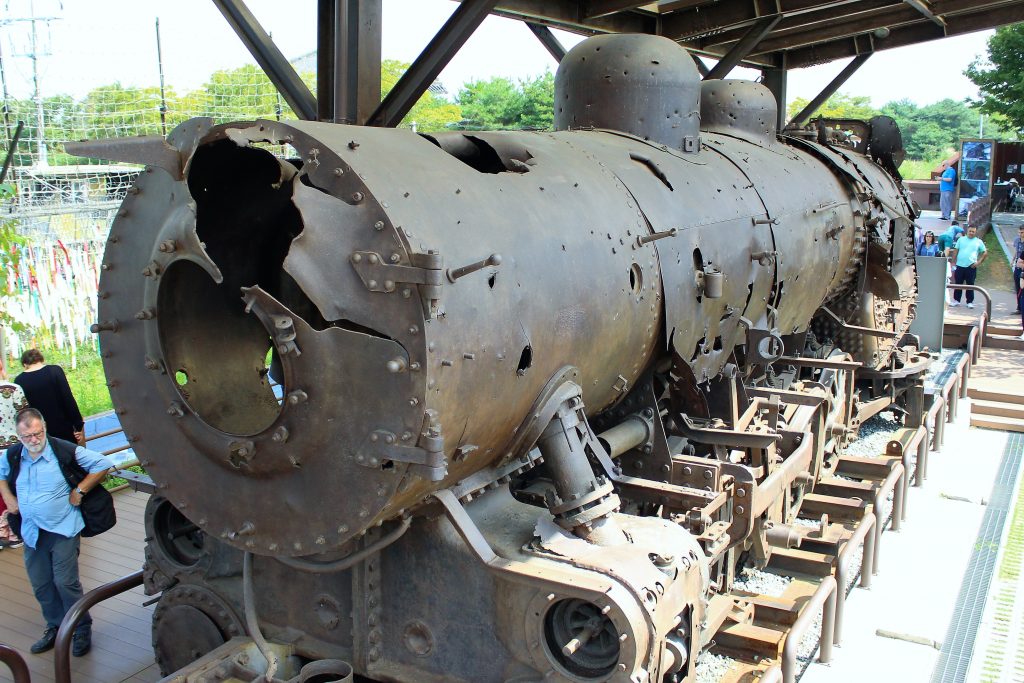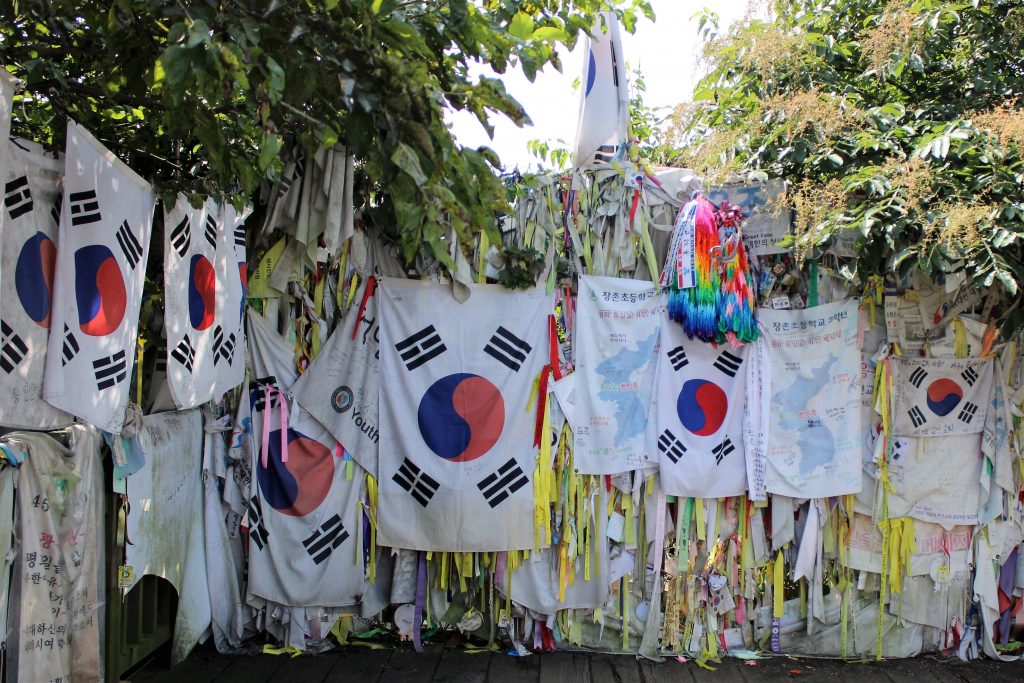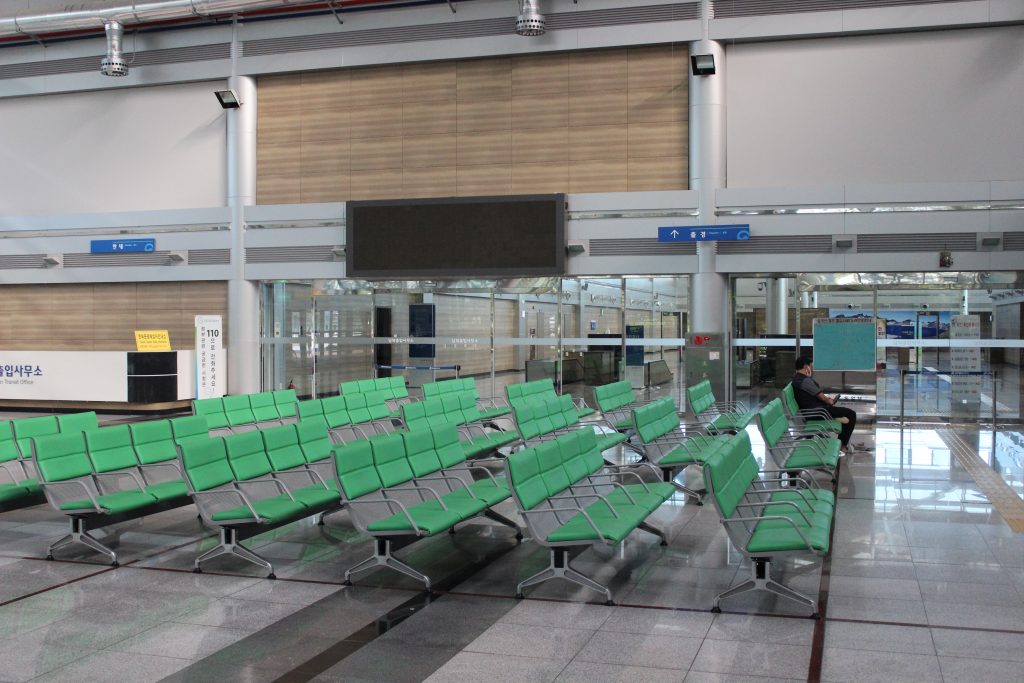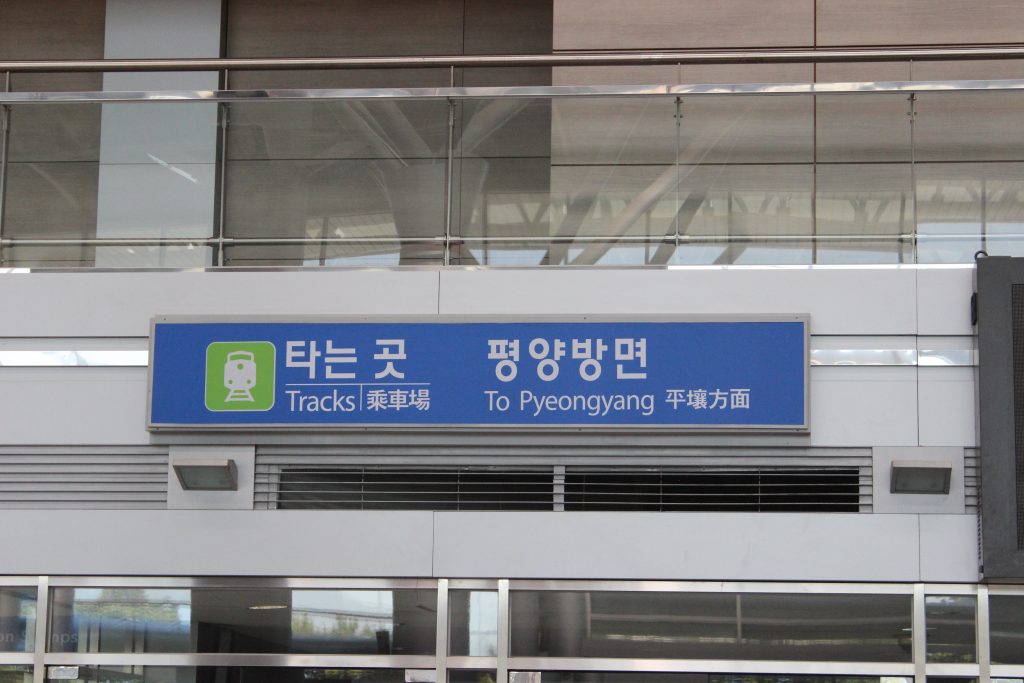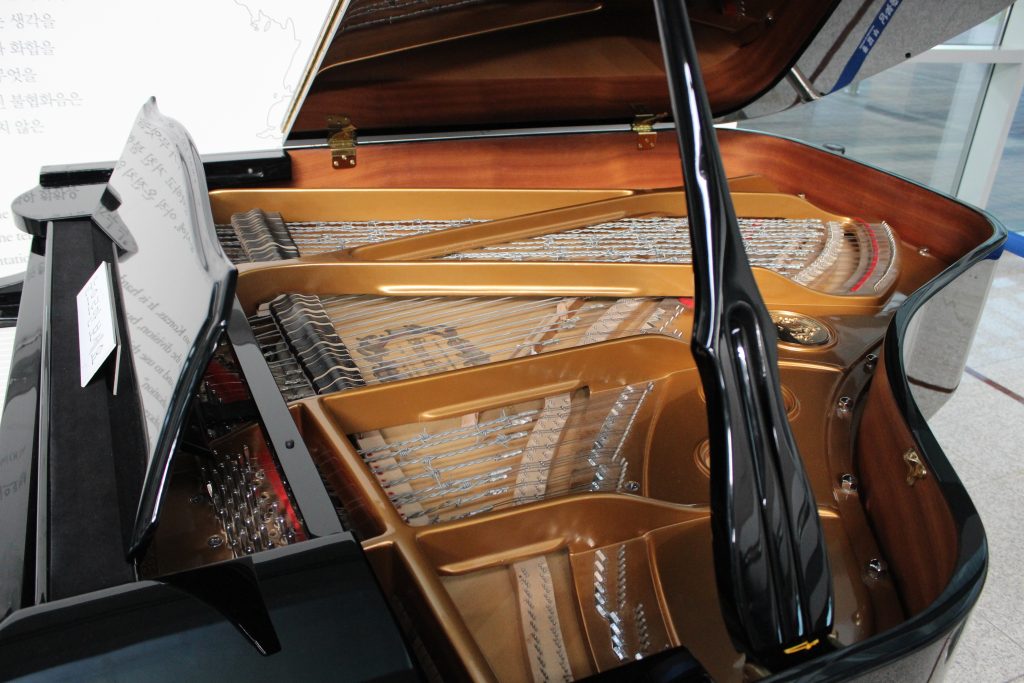Now was time to visit one of the places I was most looking forward to in Korea: the DMZ. DMZ stands for Demilitarized Zone, and it is a 4-km wide area that separates North and South Korea. Although it is called demilitarized, it is actually perhaps the most militarized place in the world. Although no soldiers are allowed inside the zone itself (nor would anybody want to step foot in a place so filled with landmines), it is heavily guarded on both sides by barbed wire and many soldiers. It seems slightly strange that this has become a major tourist attraction to people visiting Korea from either side of the border, but this is the closest many westerners will come to the secretive state of North Korea, and the appeal is there because so little is known about life inside that country.
I booked a full-day tour though Panjunmon Tour Group which included a visit to the Joint Security Area (JSA), the Freedom Bridge, lunch, an observation deck and a tunnel under the DMZ. It cost 130,000 Won, or around $114 at the time.
There was a strict dress code for the tour, which meant no shorts, sandals, ripped jeans or T-shirts. This is supposedly because the North Korean soldiers will photograph westerners wearing “poor people clothes” for propaganda purposes.
I showed up to the meeting point bright and early at [time?] (well, early for me that is 😉 ). The group was fairly large, and we took up two buses. It was a fairly international group – I noticed some Americans, some French, some Germans, quite a few Singaporeans, and one large group from Japan.
We got on the bus and started driving north. One interesting part of this tour was that there was that there was an included Q&A session with somebody who had escaped from North Korea, and we could ask her quesitons about life there. It seemed like quite a struggle to escape – she paid quite a bit for somebody to smuggle her across the border to China where she worked in a restaurant for no wages for two years, and made her way to Laos where she eventually was able to come to South Korea, with the help of an NGO who helps North Korean defectors.
As we approached the river, we noticed the increasing presence of the military. The riverbank itself is guarded by barbed wire, and here we got our first glimpse of North Korea on the other side.
There were quite a few checkpoints. First there was a South Korean military checkpoint, and then one done by the US Army. At every checkpoint our passports were checked. We arrived to the JSA with our US Army escort and were given a brief introduction on the history of the DMZ and some rules to follow – we were not allowed to point, gesture, or talk to anybody on the other side. We also had to sign a form which stated the UN was not responsible in the event that we died, which was a fun souvenir to keep!
We were bussed over to the UNCMAC Conference Building, which is probably the most famous part of the DMZ and what I was most excited for. It is the blue building in which both sides talk to each other (though they have not been doing much of that recently) and which straddles the demarcation line, which is the official border between the North and South. We were made to line up double-file, and reminded the rules of the place. We were told that we were allowed to take photos facing North, but not South, which was interesting. Walking up there, you could really feel the tension in the air. The southern side was guarded by military police who wear blackout sunglasses and stand in taekwondo poses, supposedly to intimidate the North Koreans. The North side had one guard standing outside, who apparently stands out there for 12 hours at a time. There was also another man on a higher floor of the North Korean building who appeared to be cleaning the floor. At the middle of the conference building was the demarcation line, a big concrete step that served as the official border between the two countries. It was crazy to me how at this spot, the most heavily guarded border in the world appeared so open.
We were led inside the conference building and received a briefing about its own history. When tours come from the South, the table inside has some UN flags, and when tours come from the North, they have North Korea flags. There are two guards inside the building: one is to guard the door to North Korea, and the other is to prevent anybody from pulling the first guard through the door (which has actually happened in the past). They pose for photos, but will physically push you if you get too close. I asked a random member of the tour group to take my photo with the guard, but unfortunately he did not do a very good job.
As the conference building is half in the North and half in the South, this is the only place you can technically step foot inside North Korea, unless you go on a tour of the country itself. From the middle, you can look out the window: on the left is concrete which is in the North, and on the right is gravel which is in the South. Of couse, I walked to the back of the building, meaning I have technically been inside the North!
Right outside the JSA was a gift shop with North Korea-related souvenirs, and a Buddhist temple decorated with the flags of some of the foreign countries that contribute to the UN forces in Korea.
Afterwards we went to see the Freedom Bridge, named for returning South Korean prisoners of war who shouted “freedom!” as they crossed the bridge at the end of the Korean War. At the site there was a small exhibit with an old (partially destroyed?) locomotive that presumably used to drive across the bridge.
A lot of people had pinned flags, banners and penants to the barbed wire fence. I am not 100% sure what they meant, but it seemed to be related to Korean reunification.
There was also an amusement park next door which seemed a little odd to me.
Next we were taken to an observation deck located on a hill right on the outside of the DMZ where we could peer into North Korea. The tallest landmarks visible were the North and South Korean flagpoles on their respective sides of the DMZ. An interesting historical fact is that both sides were in a sort of competition to have a taller flagpole. Currently the North has the tallest. There is a viewing scope that you could pay 500 Won (less than $0.50) to look at things more closely.
The village on the Northern side closest to the DMZ is said to actually be a fake village, built to fool the world into thinking their country is doing well. The windows and doors are apparently painted on. In the distance one can see taller apartment buildings, which belong to the (real) city of Kaesong, NK. Other landmarks visible include North and South Korean outposts, which hoist their respective countries’ flags.
After that we went to one of the tunnels dug by North Korean soldiers under the DMZ. There are four of these tunnels that have been discovered, though some people believe there are many more. We were not allowed to bring anything inside at all so I do not have any photos of it. Basically you ride down something that feels like a very slow roller coaster into the ground and then walk several hundred meters through a cave up to a point. All I was thinking was “wow, the North Korean soldiers must be really short” because the tunnel was REALLY small! Luckily they gave us helmets, because there were a few taller guys on the tour who kept bumping their heads on the ceiling! Only a few of the shortest women could walk the whole tunnel without ever bending over.
Lastly, we went to Dorasan station, which at one point in time connected the northern and southern halves of Korea. This place was a little weird, as it appeared to be a full-size train station but there was absolutely nobody there, and almost no scheduled trains. There was a sign indicating that certain traveled “to Pyeongyang,” and a piano whose strings were made of barbed wire from the DMZ fence. If a rail link through North Korea were to be established, it would actually be quite amazing, as you would then be able to take a train from Europe all the way to South Korea. I know the Russian Railway system has been trying to make this happen, though for now it seems to be a future dream.
After Dorasan station we traveled back the way we came, along the river for a while and then back to Seoul.
The DMZ is quite an intriguing place, especially if you are interested in the Korean Peninsula or in military history. Never before had I really felt tension in the air just being in a certain place. As an ecologist (technically), I also have a certain interest in the place. Because the area is so heavily mined, nobody will dare step foot inside of it, and as a result the DMZ is probably one of the best preserved natural areas in Korea. After taking the tour with Panmunjom Tour Group, I do recommend them. The tour was on the pricier side, but I feel it was very well-done and I saw everything I really wanted to see plus more. I don’t know how other DMZ tours compare though, so I could be completely wrong!
Have you been to the DMZ? Was it from the North or the South? Who operated your tour? What was your experience like?
